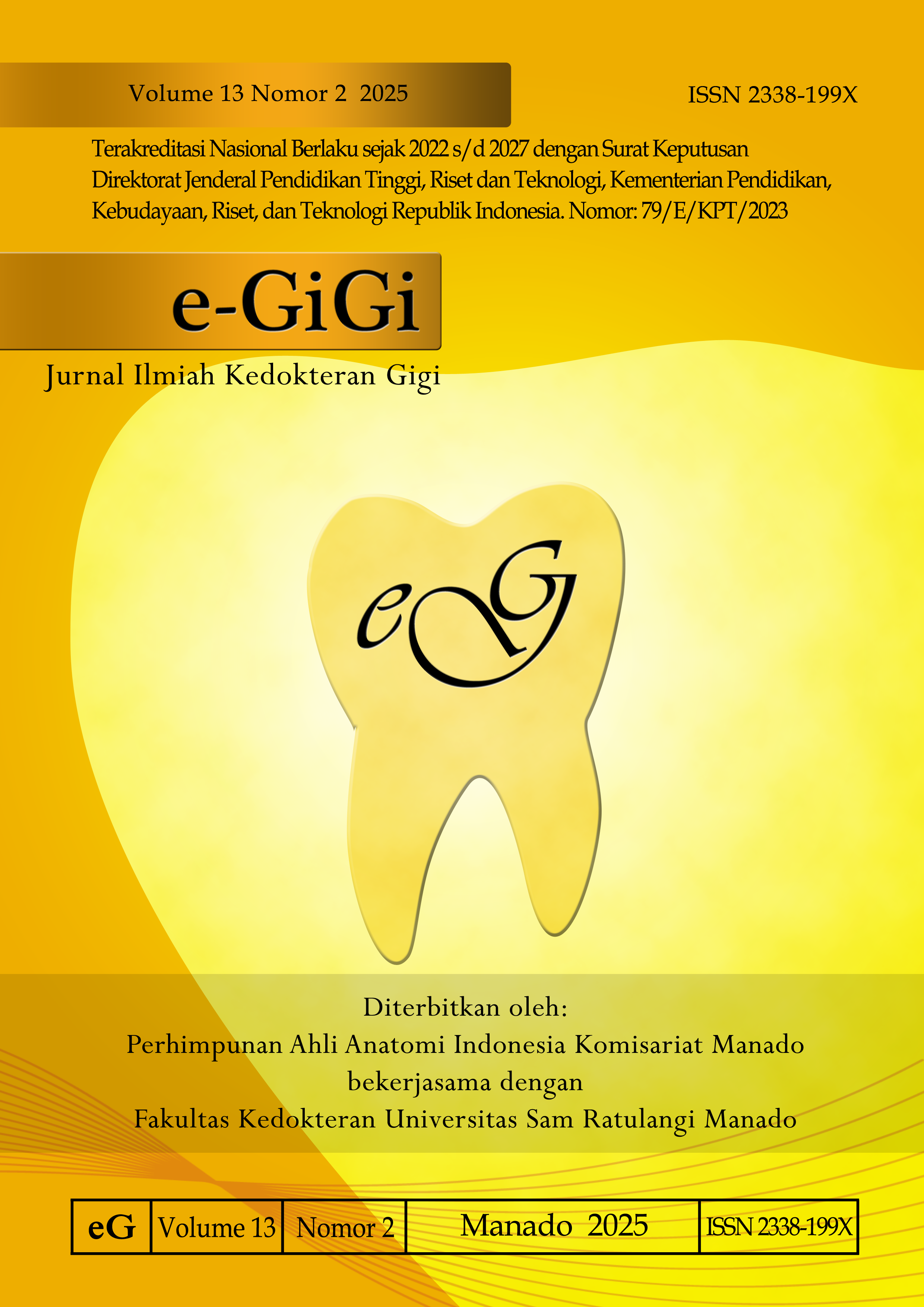Hubungan antara Tingkat Kecemasan dan Perubahan Tekanan Darah pada Pasien Pencabutan Gigi
DOI:
https://doi.org/10.35790/eg.v13i2.57300Abstract
Abstract: In dental practice, emotional states, stress, and anxiety are often found in patients. This situation can trigger a defense reaction characterized by increased sympathetic nerve activity. Blood pressure can be used as a parameter to detect the increase in sympathetic nerve activity resulting in changes in blood pressure before the tooth extraction procedure. This study aimed to evaluate the relationship between anxiety levels and changes in blood pressure in tooth extraction patients at Public Health Center. This was a descriptive and analytical study with a cross-sectional approach. Samples were taken using purposive sampling method. The results obtained 50 patients at Puskesmas Sario (Public Health Center) as respondents There were 11 respondents who were not anxious: nine (18%) respondents with fixed blood pressure, one (2%) respondent with lower blood pressure, and one (2%) respondent with increased blood pressure. There were 39 respondents with “anxiety” levels of anxiety including nine (18%) respondents with fixed blood pressure, seven (14%) with decreased blood pressure, and 23 (46%) with increased blood pressure. The paired t-test obtained a p-value of 0.001 for the relationship between anxiety level and blood pressure before tooth extraction. In conclusion, there is a relationship between the level of anxiety and changes in blood pressure in patients before the tooth extraction procedure is carried out.
Keywords: anxiety; blood pressure; tooth extraction.
Abstrak: Dalam praktik kedokteran gigi, keadaan emosi, stres, dan kecemasan sering dijumpai pada pasien yang berkunjung ke dokter gigi. Keadaan ini dapat memicu reaksi pertahanan yang ditandai dengan peningkatan aktivitas saraf simpatis. Tekanan darah dapat digunakan sebagai parameter untuk mendeteksi adanya peningkatan aktivitas saraf simpatis, yang dapat menghasilkan perubahan tekanan darah sebelum dilakukan prosedur pencabutan gigi. Penelitian ini bertujuan untuk mengevaluasi hubungan antara tingkat kecemasan dan perubahan tekanan darah pada pasien pencabutan gigi di Puskesmas. Jenis penelitian ialah deskriptif analitik dengan desain potong lintang. Sampel penelitian diperoleh menggunakan metode purposive sampling. Hasil penelitian mendapatkan 50 pasien di Puskesmas Sario sebagai responden. Terdapat 11 responden yang tidak cemas dan di antaranya terdapat sembilan (18%) responden yang tekanan darahnya bernilai tetap, satu (2%) responden dengan tekanan darah turun, dan satu (2%) responden dengan tekanan darah meningkat. Terdapat 39 responden dengan tingkat kecemasan “cemas” di antaranya sembilan (18%) responden tekanan darahnya tetap, tujuh (14%) responden tekanan darah turun, dan 23 (46%) responden dengan tekanan darah meningkat. Hasil uji t berpasangan terhadap hubungan antara tingkat kecemasan dan perubahan tekanan darah sebelum pencabutan gigi mendapatkan nilai p=0,001 (<0,005). Simpulan penelitian ini ialah terdapat hubungan antara tingkat kecemasan dengan perubahan tekanan darah pada pasien sebelum dilakukan tindakan pencabutan gigi.
Kata kunci: tingkat kecemasan; perubahan tekanan darah; pencabutan gigi
References
Hmud R, Walsh LJ. Clinical dental anxiety: causes, complications and management approaches. Int Dent. 2018;9(5):6–14. Available from: https://www.moderndentistrymedia.com/sept_oct2007/hmud.pdf
Amir H. Penanganan ansietas pada praktek kedokteran gigi (management of anxiety in the dental clinic. B-Dent. 2016;3(1):39–45. Doi: https://doi.org/10.33854/jbd.v3i1.36.g25
Armfield J. The avoidance and delaying of dental visits in Australia. Aust Dent J. 2012;57(2):243–7. Doi: 10.1111/j.1834-7819.2012.01697.x
Alaki S, Alotaibi A, Almabadi E, Alanquri E. Dental anxiety in middle school children and their caregivers: Prevalence and severity. J Dent Oral Hyg [Internet]. 2012;4(1):6–11. Available from: http://www. academicjournals.org/JDOH
Boky H. Gambaran tingkat kecemasan pasien dewasa terhadaps tindakan pencabutan gigi di Puskesmas Bahu Kecamatan Malalayang Kota Manado. e-GiGi. 2013;1(2). Doi: https://doi.org/10.35790/eg.1.2.2013.3115
Armfield JM. How do we measure dental fear and what are we measuring anyway? Oral Health Prev Dent. 2010;8(2):107–15. Available from: http://www.ncbi.nlm.nih.gov/pubmed/20589243
Rahman KM, Amir D, Noer M. Efek pencabutan gigi terhadap peningkatantekanan darah pada pasien hipertensi. J Kesehat Andalas. 2017;6(1):61. Doi: 10.25077/jka.v6i1.645
Riset Kesehatan Dasar Provinsi Sulawesi Utara. Laporan Provinsi Sulawesi Utara Tahun. 2018.
Muliana, Khasanah S, Susanti. Hubungan tingkat kecemasan dengan peningkatan tekanan darah pada pasien pre operasi benigna prostat hiperplasia (BPH) di RSUD Prof Dr. Margono Soekarjo. Viva Medika. 2016;9(16):42-50. Doi: 10.35960/vm.v10i1.301
Bachri S, Cholid Z, Rochim A. Perbedaan tingkat kecemasan pasien berdasarkan usia, jenis kelamin, tingkat pendidikan dan pengalaman pencabutan gigi di RSGM FKG Universitas Jember. e-Jurnal Pustaka Kesehat. 2017;5(1):138–44. Available from: http://repository.unej.ac.id/handle/123456789/79599
Lesmana H, Supriatna A. Gambaran kecemasan dengan perubahan tekanan darah pada pasien ekstraksi gigi di RSUD Barru. Media Kesehat Gigi. 2017;16(1):32–8. Doi: 10.32382/mkg.v18i1.998
Tamunu F, Wantania FE. Hubungan scoring dental anxiety scale dengan perubahan tekanan darah pasien ekstraksi gigi di Puskesmas Bahu. e-GiGi. 2015;3(2):386-90. Doi: 10.35790/eg.3.2.2015.9632
Arini FN, Adriatmoko W, Novita M. The alteration of vital sign as students’ anxiety symptoms before performing tooth extraction in Oral Surgery Departement Dentistry University of Jember. e-Jurnal Pustaka Kesehatan. 2017;5(2):323-7. Available from: http://repository.unej.ac.id/handle/123456789/83508
Downloads
Published
How to Cite
Issue
Section
License
Copyright (c) 2025 Christy N. Mintjelungan, Irene F. Rompas, Enjelin M. Tato

This work is licensed under a Creative Commons Attribution-NonCommercial 4.0 International License.
COPYRIGHT
Authors who publish with this journal agree to the following terms:
Authors hold their copyright and grant this journal the privilege of first publication, with the work simultaneously licensed under a Creative Commons Attribution License that permits others to impart the work with an acknowledgment of the work's origin and initial publication by this journal.
Authors can enter into separate or additional contractual arrangements for the non-exclusive distribution of the journal's published version of the work (for example, post it to an institutional repository or publish it in a book), with an acknowledgment of its underlying publication in this journal.
Authors are permitted and encouraged to post their work online (for example, in institutional repositories or on their website) as it can lead to productive exchanges, as well as earlier and greater citation of the published work (See The Effect of Open Access).






